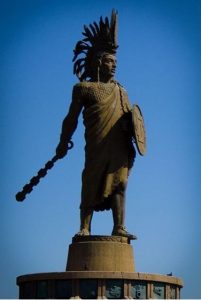By Manzanillo Sun Writer From the June 2017 Edition
Cuauhtémoc, also known as Cuauhtemotzin, Guatimozin or Guatemoc; c. 1495) was the Aztec ruler  (tlatoani) of Tenochtitlan from 1520 to 1521, making him the last Aztec Emperor. The name Cuauhtemōc means “one who has descended like an eagle”, and is commonly rendered in English as “Descending Eagle”, as in the moment when an eagle folds its wings and plummets down to strike its prey. This is a name that implies aggressiveness and determination.
(tlatoani) of Tenochtitlan from 1520 to 1521, making him the last Aztec Emperor. The name Cuauhtemōc means “one who has descended like an eagle”, and is commonly rendered in English as “Descending Eagle”, as in the moment when an eagle folds its wings and plummets down to strike its prey. This is a name that implies aggressiveness and determination.
Cuauhtémoc took power in 1520 as successor of Cuitláhuac and was a cousin of the late emperor Moctezuma II. His young wife, who was later known as Isabel Moctezuma, was one of Moctezuma’s daughters. He ascended to the throne when he was around 25 years old, while Tenochtitlan was being besieged by the Spanish and devastated by an epidemic of small- pox brought to the New World by the invaders. After the killings in the Great Temple, there were probably few Aztec captains available to take the position.
When Cuauhtemoc was elected tlatoani in 1520, Tenochtitlan had already been rocked by the invasion of the Spanish and their indigenous allies, the death of Moctezuma II, and the death of Moctezuma’s brother Cuitlahuac, who succeeded him as ruler, but died of smallpox shortly afterwards. In keeping with traditional practice, the most able candidate among the high noblemen was chosen by vote of the highest noblemen, Cuauhtemoc assumed the rulership. Although under Cuitlahuac Tenochtitlan began mounting a defense against the invaders, it was increasingly isolated militarily and largely faced the crisis alone, as the numbers of Spanish allies increased with the desertion of many polities previously under its control.
Cuauhtémoc called for reinforcements from the countryside to aid the defense of Tenochtitlán, after eighty days of warfare against the Spanish. Of all the Nahuas, only Tlatelolcas remained loyal, and the surviving Tenochcas looked for refuge in Tlatelolco, where even women took part in the battle. Cuauhté- moc was captured on August 13, 1521, while fleeing Tenochtitlán by crossing Lake Texcoco with his wife, family, and friends.
He surrendered to Hernán Cortés along with the surviving pipiltin (nobles) and, according to Spanish sources, he asked Cortés to take his knife and “strike me dead immediately.” According to the same Spanish accounts, Cortés refused the offer and treated his foe magnanimously. “You have defended your capital like a brave warrior,” he declared. “A Spaniard knows how to respect valor, even in an enemy.”
At Cuauhtémoc’s request, Cortés also allowed the defeated Mexica to depart the city unmolested. Subsequently, however, when the booty found did not measure up to the Spaniards’ expectations, Cuauhtémoc was subjected to “torture by fire,” whereby the soles of his bare feet were slowly broiled over red- hot coals, in an unsuccessful attempt to discover its whereabouts. On the statue to Cuauhtemoc, on the Paseo de la Reforma in Mexico City, there is a bas relief showing the Spaniards’ torture of the emperor. Eventually, some gold was recovered but far less than Cortés and his men expected.
Cuauhtémoc continued to hold his position under the Spanish, keeping the title of tlatoani, but he was no longer the sovereign ruler. He ordered the construction of a renaissance-style two-storied stone palace in Tlatelolco, in which he settled after the destruction of Mexico City; the building survived and was known as the Tecpan or palace.
Source: Wikipedia
Download the full edition or view it online
Manzanillo Sun’s eMagazine written by local authors about living in Manzanillo and Mexico, since 2009




